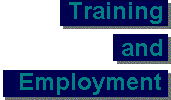 |  |
 | Youth Credits: what are they ? |
|
Youth Credits, sometimes called Training Credits are credits with a monetary value. These credits are given to all 16 and 17 year old school/college leavers so that you can purchase approved local training, but the value of training credits varies between each local area. Credits may be available if you are 18, but at this age the money is not guaranteed.
Credits can be presented to an employer or training provider to pay for training that leads to NVQs or SVQs at Level 2 or above.
|
 | What form do Youth Credits take? |
|
They come in a variety of forms - plastic credit cards, cheque book etc. The one shown here is used by Rotherham CHAMTEC. They have different names: Impact, Career Link, Prospects, Future, Next Steps (and others too) have all been used to describe Youth Credit schemes. |
 | What is so special about Youth Credits ? |
|
Youth Credits give young people personal responsibility for, involvement in and choice about their important career decisions. Youth Credits are flexible so that young people can go where they can get a good deal to make the best use of their credits. |
 | Who runs and funds the Youth Credit schemes ? |
|
The government funds the scheme and it is administered by the TECs in England and Wales and LECs in Scotland. Each organisation has to be able to demonstrate that it meets the stringent requirements to ensure quality of training.
The money comes from several sources. The European Union is a major contributor; other funding has been channelled through the Department for Education and Employment by restructuring previous funding arrangements. |
 | How much is a Youth Credit worth ? |
|
Credits are worth at least £1,000 and can go up to £2,000. For some higher level qualifications in fields such as information technology or specialist engineering, Credits may be worth £5,000 or more. Credit values are set by the Local TEC or LEC and are based on the cost of local training and the needs of a young person. This takes into account a person's special needs.
It is important to remember that a Youth Credit is not a loan and there is nothing to repay.
Some Youth Credits schemes offer inducements like bonuses for NVQ achievements and some offer concessions such as reduced fares on local transport or shopping discounts.
|
 | How do you get a Youth Credit? |
|
The first point of contact is normally a school (college) careers teacher or adviser. School-leavers can discuss career choices and plans in a friendly one-to-one interview with a careers adviser. Part of the purpose of the interview is to give you helpful guidance and advice about available options, including local training.
If employment with related training seems the best choice for you, then the adviser draws up an Action Plan. This identifies your chosen occupational area and the route you must take to achieve it. You will then receive a support pack of information about Youth Credits with application details.
|
 | How does training work with the Youth Credit scheme? |
Credits can be used to pay for training that includes:
- day release courses
- an employer's on-the-job training costs
- an evening course
- various other forms of training
If you can't find a job, you can get help from the careers service. You may be offered a training course using your credits that gives you a weekly allowance rather than a wage.
Credit balances are transferred if you move from one area to another or from one form of training to a new (approved) course.
At the end of the training period you get a detailed record of the skills, knowledge and experience you have acquired (including any qualifications) to put in your Record of Achievement.
|






